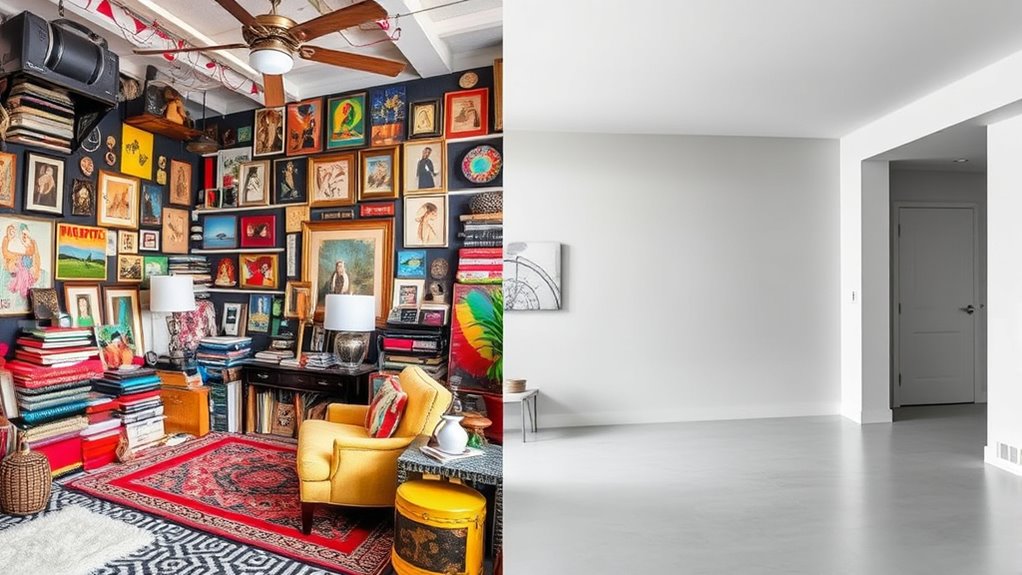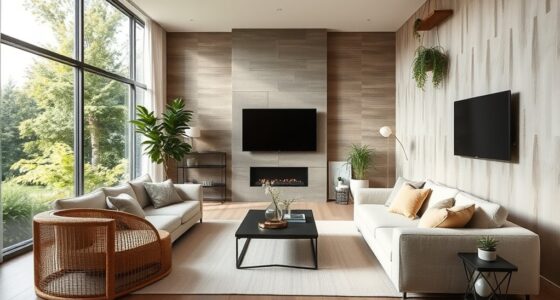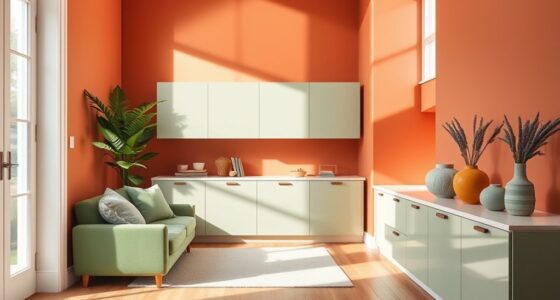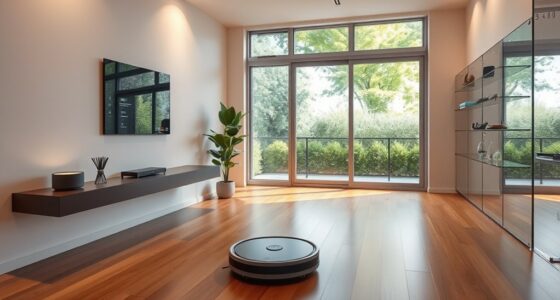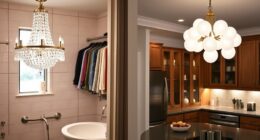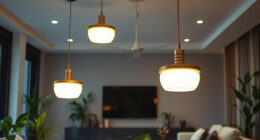If you love bold colors, layered textures, and lots of personality, maximalism might be your style. But if you prefer clean lines, open spaces, and calming neutrals, minimalism could suit you better. Think about how you want your space to feel—energized or tranquil. Both styles reflect different moods and personalities, so consider which vibe resonates most with you. Keep exploring to discover which trend truly fits your unique taste.
Key Takeaways
- Choose maximalism if you love bold colors, eclectic decor, and a lively, personalized environment; opt for minimalism if you prefer calm, clean lines, and simplicity.
- Maximalism suits those who enjoy visual richness and layering, while minimalism appeals to those seeking order, tranquility, and uncluttered spaces.
- Your personality and lifestyle influence your style choice: energetic, expressive individuals may lean toward maximalism; calm, focused individuals may prefer minimalism.
- Consider your functional needs: maximalism often involves abundant decor and objects, whereas minimalism emphasizes efficiency and essential items.
- Your environment’s mood—vibrant and stimulating or serene and understated—can help determine which trend aligns best with your aesthetic preferences.
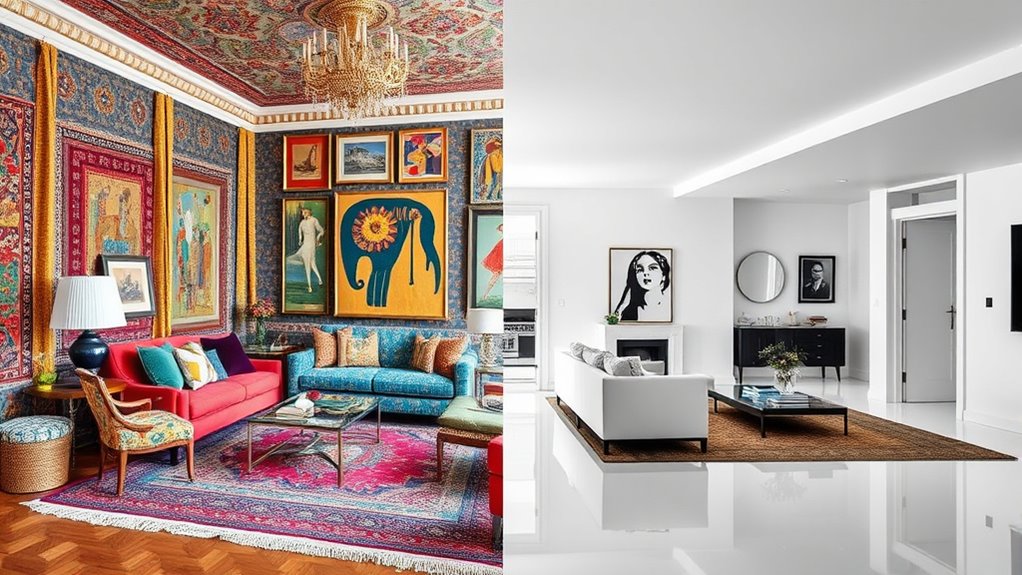
When choosing between maximalism and minimalism, you’re deciding how much visual and emotional impact you want your space or style to have. Maximalism embraces boldness and abundance, meaning your choices in color palettes and furniture choices will be vibrant, layered, and expressive. You might opt for rich, contrasting hues that create a sense of energy and personality, or combine patterns and textures to evoke a feeling of warmth and complexity. Your furniture choices could include oversized pieces, eclectic mixes, or ornate details that serve as focal points, turning your space into a lively, curated gallery. This approach encourages you to fill every corner with meaningful objects, art, and textiles, making your environment a reflection of your personality and passions. Incorporating visual diversity can help you achieve a balanced yet dynamic aesthetic that keeps the space engaging. Additionally, understanding industry trends can inform your choices and keep your decor feeling fresh and relevant. Exploring plant choices can further enhance the layered look by adding natural textures and colors that complement your maximalist style. Embracing space utilization through clever furniture arrangements and storage solutions can enhance the overall impact without overwhelming the senses.
In contrast, minimalism focuses on simplicity, clean lines, and a restrained color palette. When you lean toward minimalism, your color choices tend to be neutral—whites, blacks, soft grays, or muted earth tones—creating a calm, uncluttered backdrop. Your furniture choices are deliberate and functional, favoring sleek designs with minimal ornamentation. Think of streamlined sofas, simple tables, and storage solutions that keep surfaces clear and free of excess. This style promotes spaciousness and clarity, helping you feel more relaxed and focused. It’s about choosing quality over quantity, emphasizing the beauty of each piece and the space around it. Understanding aesthetic principles can help you better balance elements within your chosen style, whether maximalist or minimalist. Your decision ultimately hinges on how much you want your environment to energize or soothe you. Maximalism might appeal to you if you thrive on stimulation and love to showcase your personality through your surroundings. You’ll enjoy mixing colors, textures, and furniture styles, creating a layered look that’s full of surprises. Minimalism suits those who prefer calm, order, and a sense of tranquility. It allows you to breathe easier in your space, with fewer distractions and a clear sense of purpose. Your furniture choices will be more intentional, each piece carefully selected to serve a specific function while maintaining visual harmony. Both styles can be adaptable, depending on your preferences. You might incorporate elements of the other to create a personalized blend—like a minimalist room with a single bold art piece or a maximalist space with carefully curated, simple furniture. Ultimately, your style should reflect who you are and how you want to feel in your environment. Whether you choose the energetic richness of maximalism or the serene simplicity of minimalism, understanding your preferences will guide your choices in color palettes and furniture, helping you craft a space that truly feels like home.
Frequently Asked Questions
Can You Mix Both Maximalist and Minimalist Elements in One Space?
Yes, you can mix maximalist and minimalist elements in one space. You should focus on layering textures to add depth and visual interest, while balancing proportions to prevent the space from feeling overwhelming. Combine simple, sleek furniture with bold accessories or artwork, ensuring each element complements the others. This approach creates a harmonious environment where the contrasting styles coexist, making your space uniquely personalized and stylish.
How Do I Transition From Minimalism to Maximalism Seamlessly?
To shift from minimalism to maximalism seamlessly, start by layering textures like plush rugs, velvet cushions, and metallic accents. Gradually add bold patterns and vibrant colors, but keep proportions balanced so the space doesn’t feel overwhelming. You can also incorporate statement pieces that reflect your personality, ensuring each element complements the others. This way, your design evolves naturally, blending simplicity with expressive, eclectic touches.
Which Color Schemes Work Best for Maximalist vs. Minimalist Styles?
Imagine a vibrant, energetic space filled with bold hues or a calm, serene environment with soft neutrals. For maximalist styles, opt for rich, saturated color palettes that create design harmony through layering and contrast. Minimalist spaces benefit from a neutral or monochromatic color scheme, emphasizing simplicity and clean lines. Your choice of colors shapes the mood, making your space feel either lively and expressive or tranquil and understated.
Are There Specific Personality Traits That Align With Each Trend?
You might find that personality compatibility influences your style adaptability. If you’re energetic and expressive, you may naturally lean toward maximalism, embracing bold choices and vibrant designs. Conversely, if you prefer calm and simplicity, minimalism could suit you better, reflecting your preference for understated elegance. Recognizing these traits helps you select a style that feels authentic, making it easier to express yourself through your environment and personal space.
How Does Maintenance Differ Between Maximalist and Minimalist Designs?
Did you know that minimalists spend 30% less time on decor maintenance? With minimalist designs, your cleaning routines are simpler because fewer surfaces and decor items mean less dusting and organizing. Maximalist spaces, however, require more effort to keep tidy due to their abundance of decor and intricate details. So, your cleaning routines and decor maintenance will be less time-consuming if you prefer minimalism.
Conclusion
Ultimately, whether you’re drawn to the vibrant chaos of maximalism or the serene simplicity of minimalism, your style reflects your soul. Picture a room bursting with colors, textures, and layers, or a space where every item breathes, and nothing overwhelms. Trust your instincts—let your surroundings whisper your story. Embrace what resonates, and create a space that feels uniquely yours, a sanctuary where your true self can flourish amidst the beauty of choice.
